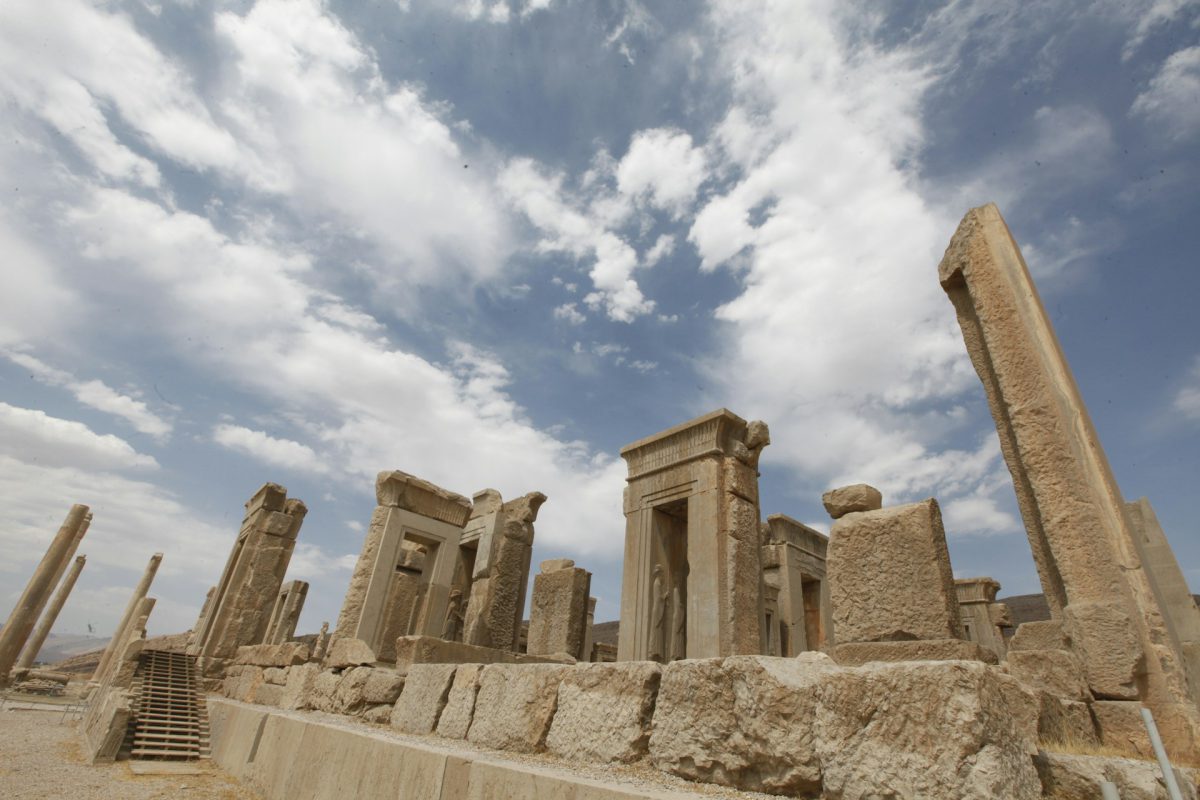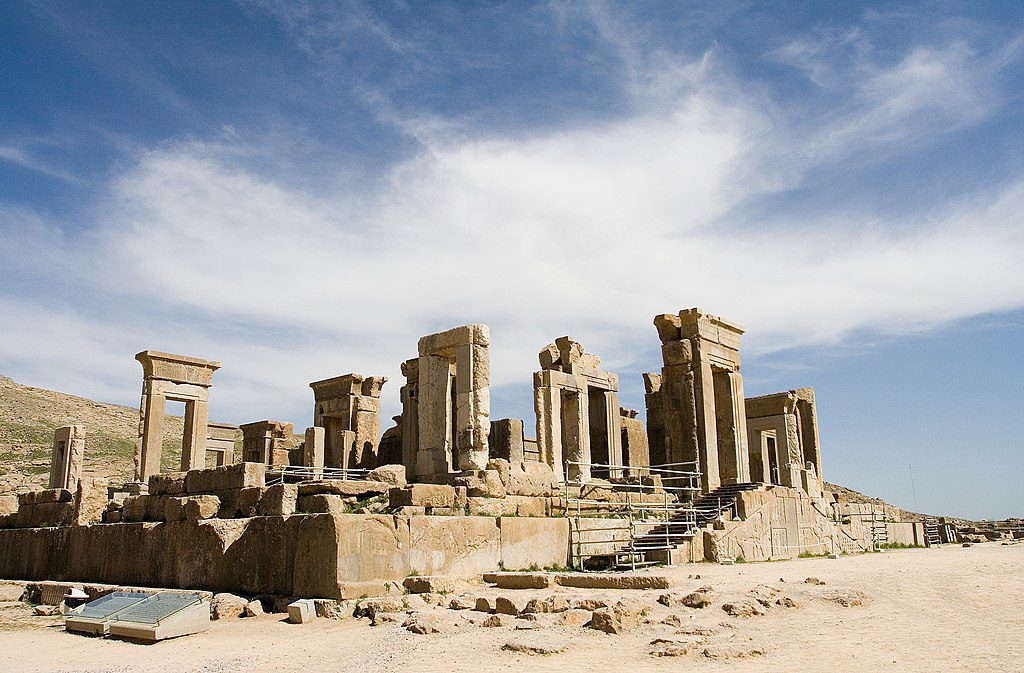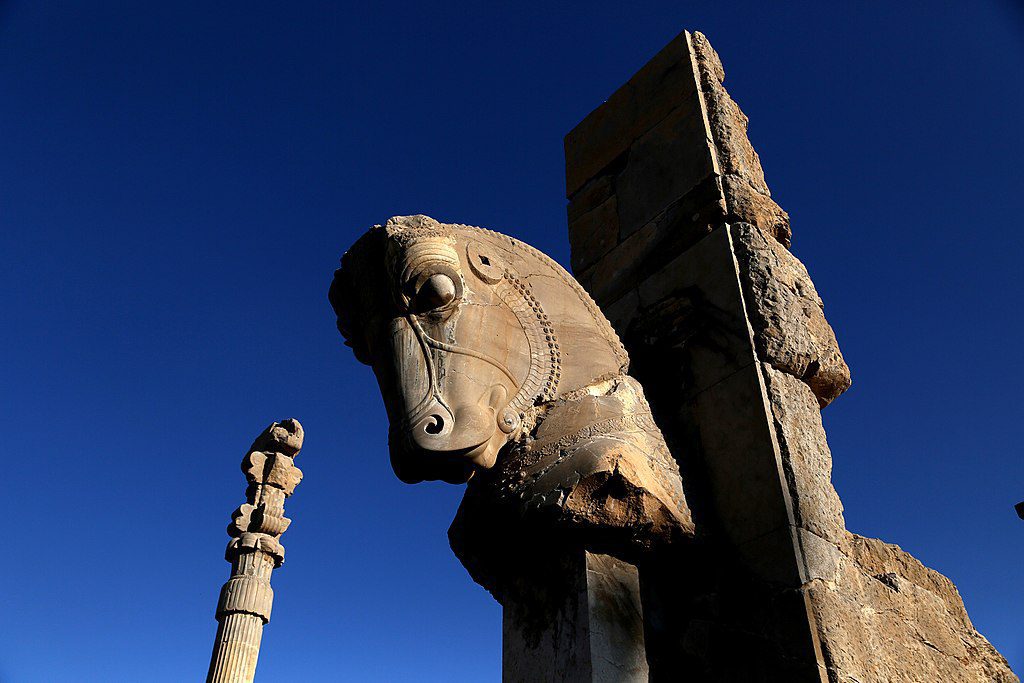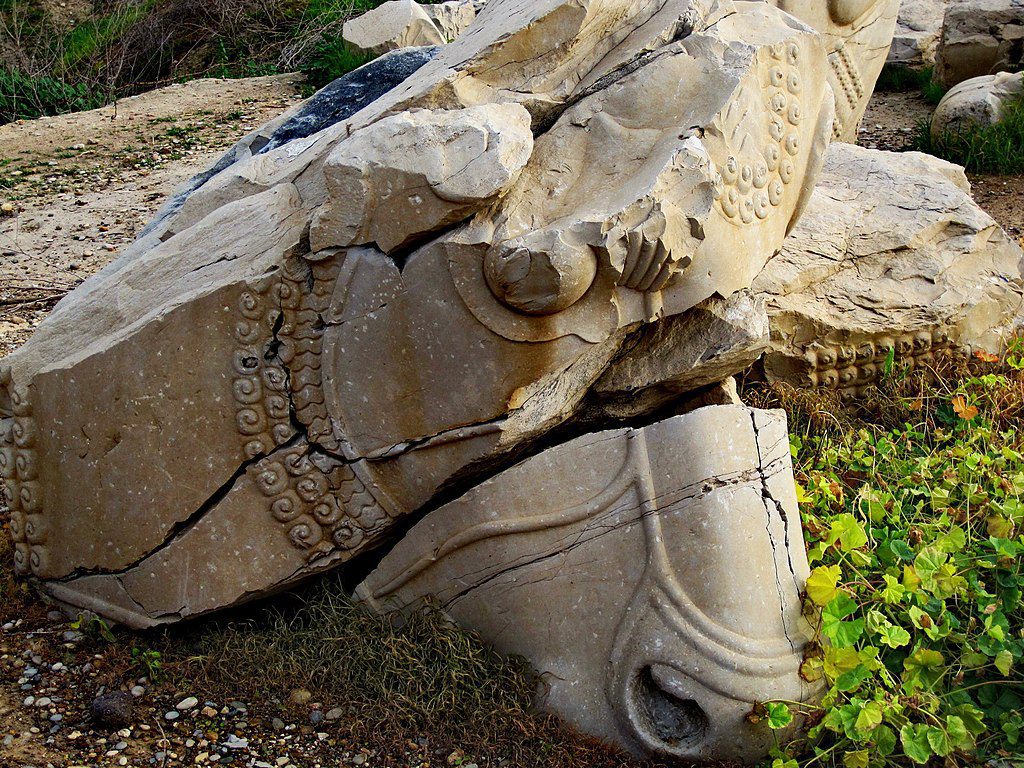Table of Contents
Ancient Persia, now known as Iran, was once the center of one of the greatest empires in human history. Its fascinating heritage has survived through the centuries, leaving a trail of awe-inspiring architectural wonders that have endured the test of time. One of these architectural wonders is the ancient city of Persepolis. Persepolis today, which was once the glorious capital of the Persian Empire, now attracts tourists from all over the world.
If you are looking to explore the historical and cultural wonders of Iran, then a visit to Persepolis today should be at the top of your list. In this blog post, we will take a closer look at this ancient city and provide you with all the information you need to plan your trip to Persepolis today.
Persepolis History
Dating back to 515 BC, Persepolis tells a story that spans centuries. Andre Godard, a French archaeologist, estimated its age, uncovering a tale of persistence. Darius I, an ancient Persian ruler, kickstarted the construction of this colossal complex. But it took over a hundred years to finish, completed under King Ardeshir I’s reign. Persepolis isn’t just about one leader’s dream; it’s about generations working tirelessly to create something truly breathtaking.
Persepolis isn’t just about grand buildings; it’s about the determination of a whole civilization. Every part of it, from the terraces to the palaces, speaks of ambition. Darius I might not have seen its completion, but his vision lives on in Persepolis. As we admire its ancient walls, we’re reminded of the incredible things humans can achieve when they put their hearts into it.
What is the Modern-Day Site of Ancient Persepolis?
In Iran’s southwest, you’ll find the ancient ruins of Persepolis, also called Takht-e Jamshid (Takht Jamshid or Takht e Jamshid). The ancient city of Persepolis was founded by Darius the Great in 518 BC, and it was the ceremonial capital of the Achaemenid Empire. The city was constructed over several decades and was finally completed in 460 BC, under the reign of Xerxes I.
Persepolis was a city of immense grandeur, and its ruins are still an impressive sight to behold. The city was designed to showcase the wealth and power of the Persian Empire, and it was filled with monumental structures, lavish palaces, and intricate works of art. Today, the ruins of Persepolis are a UNESCO World Heritage Site, and they offer a glimpse into the rich history of ancient Persia.
Why Should You Visit Persepolis today?
Visiting Persepolis today is a must-do for anyone interested in history, architecture, and culture. The ruins of Persepolis are a testament to the greatness of the Persian Empire, and they offer a unique insight into the ancient world. The site is a fascinating blend of history and art, and it is sure to leave you in awe.
Aside from its historical significance, Persepolis Shiraz is also a great place to learn about Persian culture. You can explore the ruins of the city and learn about the customs and traditions of the people who once lived there. You can also visit the nearby museum, which houses a collection of artifacts and exhibits that provide further insight into the history and culture of ancient Persia.
How to Plan Your Visit to Persepolis Today?
If you are planning a trip to Persepolis Persia, there are a few things you should keep in mind. Firstly, it is important to book your tour with a reputable tour operator. Ancient Iran Tours is one such tour operator that specializes in Iran cultural tours and historical tours of Iran.
You should also make sure that you have the necessary travel documents and visas. Iran has strict entry requirements, so it is important to plan ahead and ensure that you have all the necessary paperwork in order.
When planning your visit, you should also consider the time of year. Iran can get extremely hot during the summer months, so it may be more comfortable to visit in the spring or autumn. Finally, you should make sure that you have appropriate clothing for your visit. Iran is a conservative country, and visitors are expected to dress modestly, especially when visiting religious sites.
Attractions of Persepolis Today
Persepolis today or Takht e Jamshid is home to some of the most impressive ancient ruins in the world. Here are some of the main attractions that you can expect to see when you visit:
The Tachara Palace
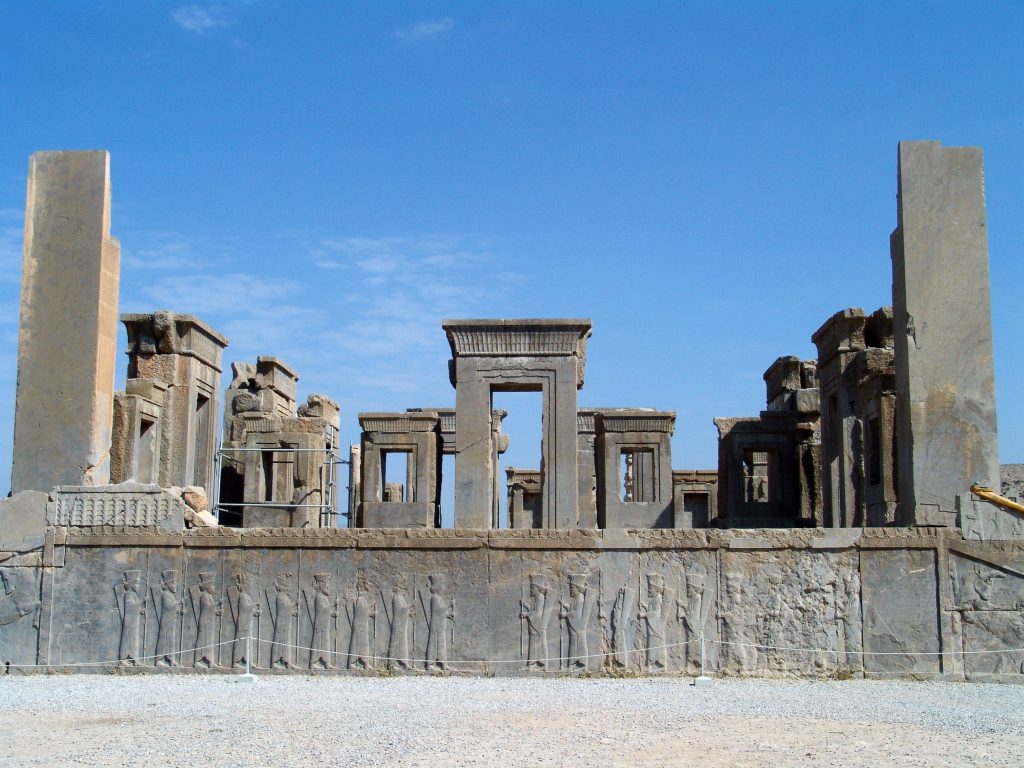
The Tachara Palace, located to the east of the Apadana Palace, was the private palace of Darius the Great. It was one of the earliest structures built in Persepolis and was used as a retreat for the royal family. The palace was constructed during the reign of Darius the Great and was later expanded by his successors.
The Tachara Palace was a relatively small structure compared to the other palaces in Persepolis. It had only one main hall and a number of smaller rooms. The palace was built on a raised platform and was accessed by a flight of stairs. The walls of the palace were decorated with reliefs depicting various scenes, including the king hunting and holding court.
One of the most interesting features of the Tachara Palace is the presence of an underground water channel. This channel brought water to the palace from a nearby spring and allowed the royal family to have access to fresh water even during times of drought. The channel was a remarkable feat of engineering and is a testament to the ingenuity of the ancient Persians.
Today, visitors to Persepolis can still see the ruins of the Tachara Palace. Although much of the palace has been destroyed over the centuries, the surviving fragments offer a glimpse into the private life of the Persian kings and their families.
The Hundred-Column Hall
The Hundred-Column Hall, or the Hall of Xerxes, was one of the most magnificent structures in Persepolis. It was built by Xerxes I and had 100 columns, hence its name. The hall was used for official ceremonies and receptions and was designed to impress and awe visitors with its grandeur.
The Hundred-Column Hall had a rectangular plan and was supported by a forest of columns. The hall was open on all sides and had no walls, allowing visitors to enjoy the views of the surrounding landscape. The columns were decorated with intricate carvings and paintings, depicting a wide range of scenes, from battles and hunts to religious ceremonies and mythical creatures.
One of the most striking features of the Hundred-Column Hall is its impressive scale. The hall was over 70 meters long and 24 meters wide, making it one of the largest structures in Persepolis. The sheer number of columns and the open design of the hall created a sense of grandeur and space that was unmatched by any other structure in Persepolis.
Although the Hundred-Column Hall was largely destroyed by Alexander the Great and his army in 330 BC, visitors can still see the ruins of the structure today. The surviving columns and fragments of the walls are a testament to the power and influence of the Achaemenid dynasty and offer a glimpse into the grandeur and sophistication of ancient Persia.
The Gate of All Nations
The Gate of All Nations, also known as the Gate of Xerxes, is the grand entrance to the ancient city of Persepolis Persia. It was built during the reign of Xerxes I and served as a ceremonial gateway for important visitors. The gate is located at the head of the grand staircase that leads up to the Apadana Palace and the other structures in Persepolis.
The Gate of All Nations is an impressive structure, standing at over 20 meters tall. It is decorated with intricate carvings and reliefs, depicting various scenes from Persian mythology and history. The gate was built to impress and awe visitors, and it certainly accomplishes that goal.
One of the most interesting features of the Gate of All Nations is the presence of four winged bulls at the entrance. These bulls were symbols of power and strength in ancient Persia and were often used in royal iconography. The bulls were also believed to have protective powers, guarding the city against evil spirits and enemies.
Today, visitors to Persepolis can still see the ruins of the Gate of All Nations. Although much of the structure has been destroyed over the centuries, the surviving fragments offer a glimpse into the power and sophistication of the Achaemenid dynasty.
The Apadana Palace
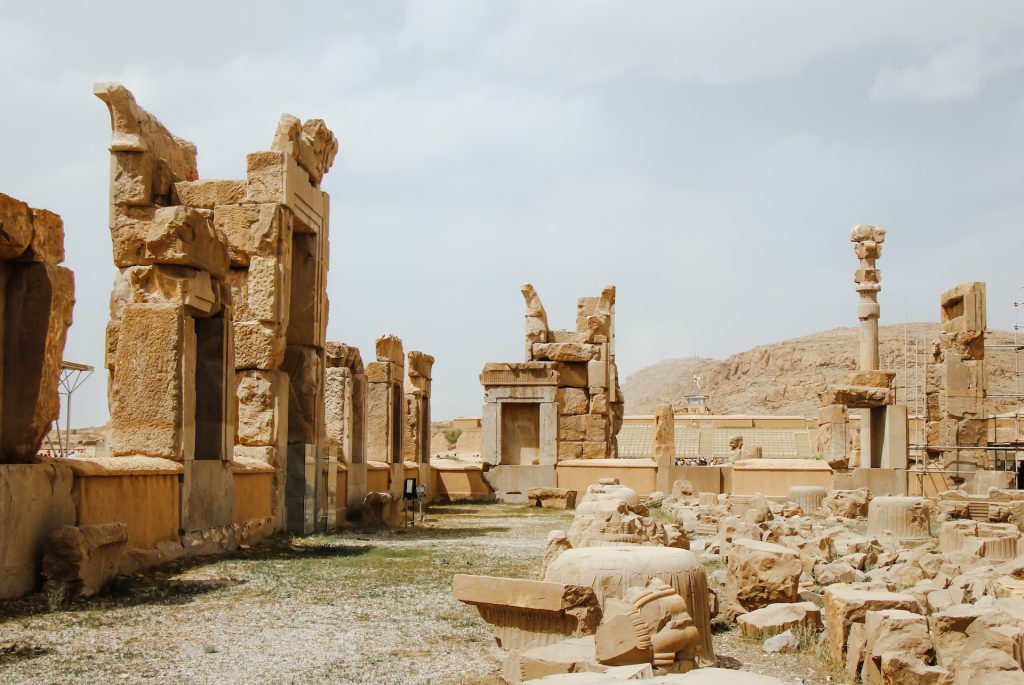
The Apadana Palace was the grandest palace in Persepolis Persia and was used for official ceremonies and receptions. It was built by Darius the Great and completed by Xerxes I. The palace was one of the most important structures in Persepolis, and it served as the center of Persian power and culture.
The Apadana Palace was a massive structure, covering an area of over 40,000 square meters. It was supported by 36 columns, each of which was over 19 meters tall. The palace was decorated with intricate carvings and paintings, depicting scenes from Persian history, mythology, and daily life.
One of the most remarkable features of the Apadana Palace is its grand staircase. The staircase was made of white limestone and had 111 steps, leading up to the palace’s main entrance. The staircase was flanked by two rows of stone columns, which were decorated with reliefs depicting various scenes.
The Treasury
The Treasury was a storage facility for the treasures of the Persian Empire. It was built by Darius the Great and was one of the most heavily guarded structures in Persepolis Persia. The Treasury was used to store all kinds of valuable items, including gold, silver, precious stones, and other precious artifacts.
The Treasury was built to protect the Persian Empire’s vast wealth, which was collected from all over the empire. The structure was heavily fortified, with thick walls and a sophisticated system of locks and traps to prevent theft. Only a few trusted individuals were allowed access to the Treasury, and even they were closely monitored.
The Necropolis
The Necropolis was the final resting place of the Achaemenid kings and their families. It is located on a nearby mountain and is accessible via a stairway that was carved into the mountain. The Necropolis is a vast complex of tombs and funerary structures, and it is one of the most important historical sites in Iran.
The Necropolis was built to honor the Achaemenid kings and to provide them with a fitting resting place. The tombs were adorned with elaborate carvings and paintings, depicting scenes from Persian mythology and history. The complex was also heavily guarded, with soldiers stationed at the entrance to prevent unauthorized access.
The Persepolis Museum

The Persepolis Museum is located near the ruins of the ancient city, and it houses a collection of artifacts and exhibits related to the history and culture of ancient Persia. The museum is a great place to learn more about the ancient city and its people.
The museum’s exhibits include a wide range of artifacts, such as pottery, jewelry, and tools, as well as sculptures and reliefs that were recovered from the ancient city’s ruins. The exhibits showcase the artistry and craftsmanship of ancient Persia and offer a fascinating glimpse into the daily lives of the people who lived in Persepolis.
One of the museum’s most impressive exhibits is the replica of the Great King’s Throne, which was originally located in the Apadana Palace. The replica was created using the same materials and techniques that were used to create the original throne, and it gives visitors a sense of the grandeur and opulence of the palace.
The Persepolis Museum also offers interactive exhibits and multimedia presentations that provide visitors with a more immersive experience. For example, visitors can explore a virtual reconstruction of the ancient city, allowing them to see what Persepolis would have looked like in its heyday.
Overall, the Persepolis Museum is a fantastic destination for anyone interested in the history and culture of ancient Persia. The museum’s exhibits offer a rich and immersive experience that is sure to leave a lasting impression on visitors. If you’re planning an Iran cultural tour or a historical tour of Iran, be sure to include the Persepolis Museum on your itinerary.
Tips for Visiting Persepolis Today
When visiting Persepolis Shiraz, there are a few tips that you should keep in mind:
Wear comfortable shoes: The ruins of Persepolis are spread out over a large area, and you will need to do a fair amount of walking to see everything. Make sure that you wear comfortable shoes to avoid getting tired.
Bring sunscreen and a hat: Iran can get extremely hot, especially during the summer months. Make sure that you bring sunscreen and a hat to protect yourself from the sun.
Dress modestly: Iran is a conservative country, and visitors are expected to dress modestly, especially when visiting religious sites. Make sure that you dress appropriately and cover your shoulders and legs.
Bring a guidebook: The ruins of Persepolis today are vast, and it can be easy to get lost or miss important structures. Bring a guidebook or hire a guide to ensure that you don’t miss anything important.
FAQs about Persepolis Today
Q1: What is Persepolis called today?
A1: The old remains of Persepolis are a really old place found in Iran, particularly in the southwest area called Fars. Persepolis, also known as Takht-e Jamshid, used to be the main city of the Achaemenid Empire, which was super strong back in ancient times.
Q2: Is Persepolis still standing?
A2: Persepolis, the old main city of the Achaemenid Empire, was partly wrecked by Alexander the Great in 330 BC. But even though it got damaged, big parts of the city are still standing today.
Q3: What happened to the city of Persepolis?
A3: Persepolis, one of the five main cities and a symbol of Persia’s power for nearly two hundred years, was attacked and set on fire by Alexander the Great in 330 BC.
Q4: Why was Persepolis banned in Iran?
A4: Persepolis faced a ban in Iran, while both the film and graphic novel were temporarily prohibited in Lebanon due to their depiction of sex and portrayal of the Iranian Revolution events. In the graphic novel, there are scenes depicting dissidents being tortured by the Iranian government.
Q5: Where is modern day Persepolis?
A5: Persepolis, the impressive ancient ruins located at the base of Kuh-e Rahmat (Mountain of Mercy) in southwestern Iran, ranks as one of the world’s most remarkable archaeological sites.
Last Words: Explore the Best of Persepolis Today with a Customized Tour
Long ago, Iran was called Ancient Persia. It had a big empire and made amazing buildings. One special place was Persepolis, which is still there today. Persepolis today used to be the capital but now people visit it for fun. If you want to learn about Iran’s old times, you should go there.
To truly enjoy your trip to Iran and explore the wonders of Persepolis today, it’s best to go on a custom-made tour. Professional companies like ToIranTour provide packages for Iran tours that are designed to fit your preferences perfectly.
So, if you’re excited to uncover the secrets of Persepolis today and experience all that Iran has to offer, let ToIranTour be your guide.

